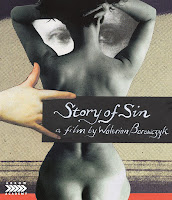- Details
-
Parent Category: Film and the Arts
-
Category: Reviews
-
Published on Tuesday, 11 April 2017 23:02
-
Written by Kevin Filipski
Blu-rays of the Week
Property Is No Longer a Theft
(Arrow Academy)
Committed left-wing Italian director Elio Petri made provocative, disturbing and enlightening political dramas in the 1970s before his untimely death from cancer at age 53 in 1982. His 1973 film is an unsubtle but irresistible riposte against capitalist society, as a lowly bank clerk insinuates himself into the personal life of a greedy local butcher, even stealing his mistress. Petri’s assured direction keeps the over-ripe performances of Flavio Bucci (clerk), Ugo Tognazzi (butcher) and Daria Nicolodi (mistress) from spinning out of control. Arrow’s terrific new set comprises a first-rate hi-def transfer and new interviews with Bucci, producer Claudio Mancini and make-up artist Pierantonio Mecacci, all of whom discuss working with the great, underrated director.
The Bye Bye Man
(Universal)
This hopelessly confused attempt at a psychological haunted-house flick has flat acting—including stalwarts Faye Dunaway and Carrie-Anne Moss—a hollow script and contempt for an audience that expects honest scares, not lamely risible “shocks.” Director Stacy Title once made an interesting little black comedy, The Last Supper, two decades ago, but her latest doesn’t approach that. The hi-def transfer is good; the unrated version is three minutes longer than the theatrical version.
Daughters of the Dust
(Cohen Film Collection)
Julie Dash’s enveloping 1991 historical drama highlights an obscure chapter in American history: the Gullah community, comprising former slaves and their descendants, who are living on the Sea Islands off the South Carolina coast at the turn of the 20thcentury, decide whether to migrate to the mainland. Dash’s ability to vividly personalize history is on display throughout her memorable memory film; the enticing hi-def transfer and many extras—Dash’s commentary and interview, Q&A with Dash and actress Cheryl Bruce, and interview with Dash’s superb cinematographer Arthur Jafa—make this an essential package.
House—Two Stories
Dead or Alive
(Arrow)
The tongue-in-cheek horror movie House became a cult item in 1986, and was followed a year later by the far worse House II; the original at least had William Katt, John Wendt and a sorely underused Kay Lenz, while the latter was stuck with John Ratzenberger. Japanese cult director Takashi Miike made his ultra-violent Dead or Alive trilogy between 1999 and 2002; wildly ambitious and wildly uneven, these Yakuza movies are the ultimate triumphs of style over substance. Both sets show off Arrow’s excellent hi-def transfers, vintage and current interviews and making-ofs, commentaries, and hour-long appraisals of both House films.
Story of Sin
(Arrow Academy)
Polish director Walerian Borowczyk—who died in 2006—has seen his cult reputation grow ever larger, thanks to the availability of even his most obscure films on DVD and now Blu-ray, like the only film he made in his home country, 1974’s Story of Sin. This less-graphic-than-usual, consistently intriguing adaptation of Stefan Żeromski’s novel concerns a young religious woman soiled by her loss of innocence (a whale of a lead performance by actress Grazyna Dlugolecka). As usual with Arrow Academy, great care has gone into the presentation of an obscure feature by a barely-remembered Polish director: stunning transfer, audio commentary, new and vintage interviews and appraisals, and several Borowczyk shorts.
World Without End
(Warner Archive)
You’d think a forgotten 1956 sci-fi B movie wouldn’t be high on the list of hi-def re-issues by Warner Archive, but then again, this is a forgotten sci-fi B movie, the kind of thing that appeals to movie buffs who buy Blu-rays. A quartet of astronauts crash-lands on a distant planet, only to find they’ve returned to a post-nuclear Earth nearly 600 years in the future. Weak acting, cheesy script, cheap sets and effects and muddled philosophy are the draws here; the spectacular hi-def transfer will look terrific on movie buffs’ large TV screens.
DVDs of the Week
A Girl in Every Port
(Warner Archive)
Made after the Marx Brothers’ creative peak, this 1952 comedy wastes Groucho’s final leading role as a sailor (!) who—with his sidekick William Bendix—gets caught up in a convoluted mess involving twin horses and a blonde femme fatale (the juiceless Marie Wilson). Groucho gets to fire off several one-liners but few of them hit in this scattershot (to be kind) comedy. Watch Duck Soup, A Night at the Opera or even Horse Feathers instead.
 Toni Erdmann
Toni Erdmann(Sony Pictures Classics)
I may be the lone dissenter when it comes to Maden Ade’s overlong and slender portrait of a practical-jokester father who surprises his successful daughter in Bucharest—only to bug her mercilessly. The problem is that dad is a mere plot device instead of a believable character; indeed, once he shows up, Ade seems to be trolling her own movie. Despite impressive acting by Peter Simonischek and Sandra Hüller, this ends up as irritating as Ade’s previous Everything Else. That Sony is releasing this on DVD and BD-R is a sign Criterion will put out a packed Blu-ray edition soon. Extras are an Ade commentary and AFI Fest Q&A.
CD of the Week
Beethoven—Complete String Quartets
(Decca)
The best recent boxed set of Beethoven’s complete string quartets is by the Takacs Quartet, which digs into these 16 masterly musical statements (17, if one counts the inscrutable Grosse Fuge) and makes them its own, especially its scintillating readings of the six late quartets, those incredible, forward-thinking works from 1825 and 1826, which reached their apogee with the quicksilver Op. 135. This attractively-designed set includes seven CDs of the quartet’s illuminating performances, a DVD of them playing Beethoven (Op. 59, No. 1), Schubert (“Death and the Maiden”) and Haydn (“The Bird”), and a Blu-ray Audio disc of what’s on the CDs in high fidelity pure audio.


















